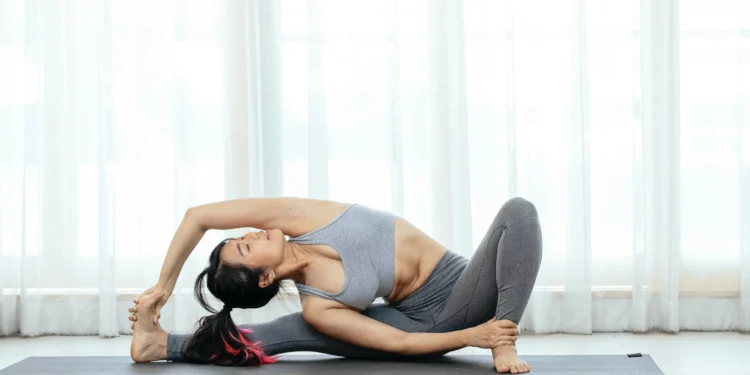Yoga and stretching have long been known for their therapeutic benefits when it comes to pain relief. These practices offer a natural and holistic approach to managing pain, improving overall well-being, and promoting a healthier lifestyle.
Regular practice of yoga and stretching can bring about a myriad of benefits. Not only do they enhance strength and flexibility, but they also improve balance and posture. These exercises work on a deep level, targeting the muscles, joints, and connective tissues, helping to alleviate pain and discomfort.
One of the key advantages of incorporating yoga and stretching into a pain relief routine is their ability to target specific areas. Whether you’re experiencing back pain, arthritis, or general muscle soreness, there are various poses and stretches that can provide targeted relief.
Key Takeaways:
- Regular yoga and stretching practice can improve strength, balance, and flexibility.
- Yoga has been shown to be effective in relieving back pain and managing arthritis symptoms.
- Yoga promotes heart health, better sleep, increased energy, and improved mood.
- These practices help manage stress, promote self-care, and foster a sense of community.
- Consider incorporating yoga therapy and seeking guidance from qualified teachers for maximum benefits.
Yoga Strengthens the Body
Yoga offers a wide range of benefits, including improved strength, balance, and flexibility. By incorporating slow movements and deep breathing, yoga increases blood flow and warms up the muscles, preparing them for the practice ahead.
One of the key aspects of yoga is holding poses, which builds both physical and mental strength. As you engage your muscles to maintain stability in various poses, you gradually develop greater strength throughout your body.
Regular yoga practice also improves balance by challenging your stability and coordination. Through consistent practice, you can enhance your ability to maintain equilibrium, improving your overall balance in daily activities.
Flexibility is another significant benefit of yoga. As you move through different poses, you gently stretch and lengthen your muscles, gradually expanding your range of motion. This increased flexibility not only improves physical performance but also helps prevent injuries.
To illustrate the strengthening effects of yoga, here is a brief table showcasing some commonly practiced yoga poses and the areas of the body they target:
| Yoga Pose | Areas of the Body Targeted |
|---|---|
| Downward Dog Pose | Arms, shoulders, hamstrings, calves |
| Warrior II Pose | Legs, hips, arms, shoulders |
| Plank Pose | Core muscles, arms, shoulders |
| Tree Pose | Legs, hips, calves, core muscles |
These are just a few examples of the many yoga poses that contribute to overall strength, balance, and flexibility. Consistent practice and progression in these poses can lead to notable improvements in physical fitness.
As you can see, yoga offers a holistic approach to strengthening the body, benefiting both physical and mental well-being. With its focus on slow movements, deep breathing, and holding poses, yoga provides a comprehensive workout that enhances strength, balance, and flexibility.
Yoga for Back Pain Relief
According to the American College of Physicians, yoga is recommended as a first-line treatment for chronic low back pain. Not only does it provide relief, but it also improves mobility and overall well-being. Two yoga poses that are particularly effective in alleviating back pain are the Cat-Cow Pose and the Downward Dog Pose.
The Cat-Cow Pose targets the spine, gently stretching and mobilizing the back muscles. This pose helps relieve tension and improve flexibility in the spine, reducing back pain. By moving between these two poses, individuals experiencing back pain can also promote spinal fluid circulation.
The Downward Dog Pose is known for its ability to stretch and strengthen the entire body, including the back muscles. It elongates the spine, decompresses the vertebral discs, and lengthens the hamstrings. With regular practice, this pose can enhance spine alignment and alleviate back pain.

Yoga is an effective and holistic approach to managing back pain. By incorporating simple yet powerful poses like the Cat-Cow and the Downward Dog, individuals can find lasting relief and improved mobility.
Yoga for Arthritis Relief
Gentle yoga has shown promising results in providing relief for individuals suffering from arthritis. This ancient practice offers a holistic approach to managing arthritis symptoms, including discomfort and swelling in the joints. Studies have consistently demonstrated the effectiveness of yoga as a complementary therapy for arthritis management.
One notable benefit of yoga for arthritis is its ability to improve flexibility and range of motion. Regular practice can help alleviate stiffness and enhance joint mobility, allowing individuals to perform daily activities more comfortably. Moreover, yoga promotes increased muscle strength, which plays a crucial role in supporting joint function and stability.
“Yoga has been proven to be a safe and effective complementary therapy for individuals with arthritis. It enhances physical function, reduces pain, and improves overall well-being.”
Yoga’s emphasis on deep breathing and relaxation techniques also contributes to pain relief and stress reduction. By calming the mind and reducing anxiety, individuals may experience a reduction in arthritis symptoms, including pain and inflammation. Additionally, the gentle movements and stretching exercises performed in yoga can help promote circulation and reduce joint swelling.
It’s important to note that yoga should be practiced under the guidance of a qualified instructor who understands the unique needs and limitations of individuals with arthritis. They can tailor the practice to accommodate any physical restrictions and ensure proper alignment to prevent further discomfort.
Recommended Yoga Poses for Arthritis Relief
Here are a few yoga poses that are particularly beneficial for individuals with arthritis:
- Child’s Pose (Balasana): This gentle resting posture helps stretch the lower back, hips, and thighs, providing relief to the joints and calming the mind.
- Bridge Pose (Setu Bandhasana): This pose strengthens the muscles supporting the spine and opens up the chest, reducing pressure on the joints.
- Triangle Pose (Trikonasana): This standing pose stretches and strengthens the legs, while also improving balance and enhancing joint mobility.
- Corpse Pose (Savasana): This final relaxation pose promotes deep relaxation and encourages a sense of calmness, reducing stress and tension in the body.
Individuals with arthritis should always listen to their bodies and modify poses as needed. The goal is to find a balance between stretching and strengthening without causing any additional pain or discomfort.
By incorporating yoga into their daily routine, individuals with arthritis can experience relief from symptoms, improve their overall well-being, and enhance their quality of life. This integrative approach offers a natural and effective way to manage arthritis, promoting physical strength, flexibility, and emotional well-being.
Yoga for Heart Health
Regular yoga practice is not only great for improving flexibility and reducing stress but also plays a significant role in promoting heart health. Yoga offers a holistic approach to heart disease prevention by addressing risk factors such as high blood pressure, inflammation, and excess weight.
One of the key benefits of yoga for heart health is its ability to lower stress levels. The deep breathing and mindfulness practiced in yoga help calm the mind and reduce stress, which can be a major contributor to heart disease. By incorporating yoga into your routine, you can effectively manage stress and improve your overall cardiovascular health.
“Yoga can significantly reduce blood pressure and lower the heart rate, both of which are key factors in maintaining a healthy heart.”
In addition to reducing stress, yoga has been found to lower inflammation in the body. Chronic inflammation is associated with an increased risk of heart disease, so by practicing yoga regularly, you can help protect your heart from potential damage.
Furthermore, yoga can help address common risk factors for heart disease, such as high blood pressure and excess weight. Various yoga poses, including standing poses and inversions, can promote healthy blood flow, improve circulation, and aid in maintaining a healthy weight.
By integrating yoga into your lifestyle and incorporating it as part of your heart disease prevention plan, you can take proactive steps towards maintaining a healthy heart and reducing the risk of cardiovascular conditions.
Experience the power of yoga for heart health today and reap the benefits it offers to improve your overall well-being.

Yoga Poses for Heart Health:
- Mountain Pose
- Triangle Pose
- Bridge Pose
- Camel Pose
Yoga for Better Sleep and Mood
When it comes to improving sleep quality and boosting mood, yoga has proven to be a valuable practice. Research has shown that incorporating a consistent bedtime yoga routine can have a significant impact on sleep patterns and overall well-being.
By engaging in mindful movements, deep breathing, and relaxation techniques, individuals can create a calm and soothing environment conducive to a peaceful night’s sleep.
One of the primary benefits of yoga for sleep is its ability to help regulate the body’s stress response. By activating the parasympathetic nervous system, yoga promotes relaxation and reduces anxiety, allowing the mind and body to unwind before bedtime.
This can be particularly beneficial for those who struggle with insomnia or frequently experience racing thoughts that hinder sleep.
Regular yoga practice also contributes to mental and physical energy levels throughout the day. By incorporating gentle stretches, invigorating flows, and energizing breathwork, yoga helps increase circulation, release tension, and awaken the body.
These practices can provide a natural alternative to caffeinated beverages and help combat mid-day sluggishness, promoting both mental clarity and physical vitality.
In addition to its sleep-enhancing and energy-boosting effects, yoga has a profound impact on mood regulation. The mindful nature of yoga allows individuals to cultivate a deeper connection with themselves and their emotions.
Through focused awareness and self-reflection, yoga practitioners can develop a greater sense of emotional stability, resilience, and overall well-being.
“Yoga is the journey of the self, through the self, to the self.” – The Bhagavad Gita
By incorporating yoga into their daily routine, individuals can experience a multitude of benefits including improved sleep quality, heightened mental and physical energy, and enhanced mood. Whether through gentle evening flows or invigorating morning sequences, yoga offers a holistic approach to nurturing both the body and mind.
Yoga Poses for Better Sleep and Mood:
- Child’s Pose (Balasana): Calms the nervous system and relieves tension.
- Legs Up the Wall (Viparita Karani): Promotes relaxation and increases blood circulation.
- Corpse Pose (Savasana): Induces deep relaxation and prepares the body for sleep.
- Bridge Pose (Setu Bandhasana): Helps reduce anxiety and fatigue, while strengthening the back.
Managing Stress through Yoga
Yoga is not only beneficial for physical health but also plays a pivotal role in managing stress and promoting mental well-being. According to the National Institutes of Health, yoga supports stress management, mental health, mindfulness, healthy eating, weight loss, and quality sleep.
By incorporating regular yoga practice into your daily routine, you can experience a range of positive effects on your overall stress levels.
One particularly helpful pose for relaxation and stress reduction is the Corpse Pose (Savasana). This pose involves lying flat on your back with your arms and legs slightly separated, allowing your body to completely relax.
By focusing on your breath and releasing tension from each part of your body, you can experience a deep sense of calm and rejuvenation.
Take a few moments throughout your day to practice this pose and give yourself permission to unwind and let go of stress. Set aside a quiet space where you won’t be disturbed and take slow, deep breaths as you allow your body to sink into the floor.
With regular practice, you’ll notice a profound shift in your ability to manage stress and cultivate mindfulness.
“Yoga is the journey of the self, through the self, to the self.” – Bhagavad Gita
By incorporating yoga into your stress management routine, you can harness its power to calm your mind, reduce anxiety, and improve your overall mental health.
Mindfulness techniques, such as focusing on your breath and being fully present in the moment, can help break the cycle of stress and allow you to approach challenging situations with greater clarity and perspective.
In addition to its mental health benefits, yoga also encourages healthy habits such as mindful eating and regular physical activity, which further contribute to stress reduction. This holistic approach to well-being makes yoga a powerful tool for managing stress and promoting overall wellness.
| Benefits of Yoga for Stress Management: |
|---|
| Reduces stress levels |
| Improves mental health |
| Promotes mindfulness |
| Encourages healthy eating habits |
| Aids in weight loss |
| Enhances quality sleep |
Conclusion
Yoga and stretching offer a natural and effective approach to pain relief. These practices provide a wide range of physical and mental health benefits, improving overall well-being. Incorporating yoga therapy into a comprehensive pain management plan can be highly beneficial.
Regular yoga practice enhances strength, balance, and flexibility, while also promoting heart health and better sleep. It can help alleviate back pain and manage symptoms of arthritis. Yoga is a versatile and accessible form of exercise suitable for people of all ages and fitness levels.
To maximize the benefits of yoga, it is important to seek guidance from qualified teachers who can provide proper instruction and ensure safe practice. Yoga therapy can be a valuable addition to traditional pain management techniques, offering a holistic approach focused on natural pain relief and overall wellness.
In today’s busy and stressful world, integrating yoga into our lives can truly make a difference. By prioritizing self-care and embracing the power of yoga, individuals can discover a valuable tool for pain management and take control of their well-being.
FAQ
What are the benefits of yoga and stretching for pain relief?
Yoga and stretching offer numerous benefits for pain relief. Regular practice can improve strength, balance, and flexibility. Yoga helps with back pain and can ease arthritis symptoms. It also benefits heart health, promotes better sleep, increases energy, and improves mood.
Additionally, yoga helps manage stress, promotes self-care, and connects individuals with a supportive community.
How does yoga strengthen the body?
Yoga involves slow movements and deep breathing, which increase blood flow and warm up muscles. Holding poses builds strength. Regular yoga practice improves balance and increases flexibility.
Can yoga help with back pain relief?
Yes, yoga is recommended as a first-line treatment for chronic low back pain by the American College of Physicians. Poses such as Cat-Cow Pose and Downward Dog Pose are known to alleviate back pain and improve mobility.
Is yoga beneficial for arthritis relief?
Yes, gentle yoga has been shown to ease discomfort and reduce swelling in joints affected by arthritis. Studies have proven its effectiveness in managing arthritis symptoms.
How does yoga benefit heart health?
Regular yoga practice reduces stress levels, lowers inflammation, and addresses risk factors for heart disease such as high blood pressure and excess weight.
Can yoga improve sleep quality and mood?
Research has shown that a consistent bedtime yoga routine can improve sleep quality. Practicing yoga regularly also boosts mental and physical energy and enhances mood, leading to a more positive outlook.
How can yoga help with stress management?
Yoga supports stress management, mental health, mindfulness, healthy eating, weight loss, and quality sleep, according to the National Institutes of Health. Poses such as Corpse Pose (Savasana) are helpful for relaxation and stress reduction.
How can yoga and stretching offer natural pain relief?
Yoga and stretching provide physical and mental health benefits, improve overall well-being, and can be integrated into a comprehensive pain management plan. Consider incorporating yoga therapy and seeking guidance from qualified teachers to maximize the benefits of these practices.



























